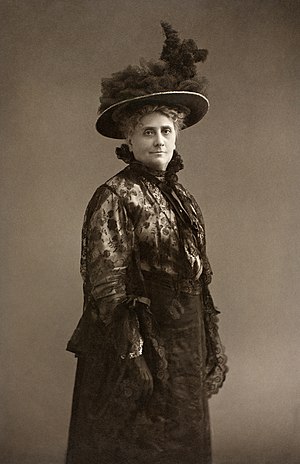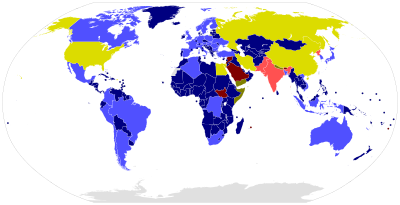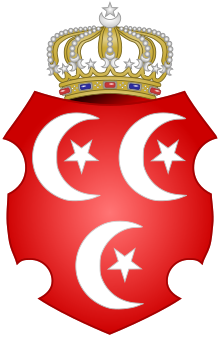
Back Portal:Politik ALS بوابة:السياسة Arabic بوابة:سياسة ARZ Портал:Политика Bulgarian প্রবেশদ্বার:রাজনীতি Bengali/Bangla Portal:Politika BS دەروازە:سیاسەت CKB Portál:Politika Czech Portal:Politik German Portal:Siyaset DIQ
| Main | Topics and categories | Tasks and projects |
The Politics portal
Politics (from Ancient Greek πολιτικά (politiká) 'affairs of the cities') is the set of activities that are associated with making decisions in groups, or other forms of power relations among individuals, such as the distribution of resources or status. The branch of social science that studies politics and government is referred to as political science.
It may be used positively in the context of a "political solution" which is compromising and non-violent, or descriptively as "the art or science of government", but also often carries a negative connotation. The concept has been defined in various ways, and different approaches have fundamentally differing views on whether it should be used extensively or in a limited way, empirically or normatively, and on whether conflict or co-operation is more essential to it.
A variety of methods are deployed in politics, which include promoting one's own political views among people, negotiation with other political subjects, making laws, and exercising internal and external force, including warfare against adversaries. Politics is exercised on a wide range of social levels, from clans and tribes of traditional societies, through modern local governments, companies and institutions up to sovereign states, to the international level.
In modern nation states, people often form political parties to represent their ideas. Members of a party often agree to take the same position on many issues and agree to support the same changes to law and the same leaders. An election is usually a competition between different parties.
A political system is a framework which defines acceptable political methods within a society. The history of political thought can be traced back to early antiquity, with seminal works such as Plato's Republic, Aristotle's Politics, Confucius's political manuscripts and Chanakya's Arthashastra. (Full article...)
Selected article
The monarchy of the United Kingdom is a system of government in which a hereditary monarch is the sovereign of the United Kingdom and its overseas territories. The terms British monarch and British monarchy may mean different things in different contexts beyond the United Kingdom. The present monarch is Queen Elizabeth II, who has reigned since 6 February 1952. The heir apparent is her eldest son, Charles, Prince of Wales and Duke of Rothesay. They and the Queen's husband and consort, Prince Philip, Duke of Edinburgh, undertake various public duties in accordance with their positions. Elizabeth II is Head of the Commonwealth and also reigns as head of state of 15 other Commonwealth countries. This developed from the former colonial relationship of these countries to Britain, but they are now independent and the monarchy of each is legally distinct.
Featured picture

Gina Krog (20 June 1847 – 14 April 1916) was a Norwegian suffragist, teacher, liberal politician, writer and editor. She played a central role in the Norwegian women's movement from the 1880s until her death, notably as a leading campaigner for women's right to vote. In 1884, Krog co-founded the Norwegian Association for Women's Rights with liberal MP Hagbart Berner. Over the next two decades, Krog co-founded the Women's Voting Association, the National Association for Women's Suffrage, and the Norwegian National Women's Council, spearheading the presentation of women's suffrage proposals to the Storting (the Norwegian parliament). She was an early member of the Liberal Party and served as a deputy member of its national board.

The governor of New York is the head of government of the U.S. state of New York, the head of the executive branch of New York's state government, and the commander-in-chief of the state's military forces. The officeholder has a duty to enforce state laws, to convene the New York State Legislature, the power to either approve or veto bills passed by the legislature, as well as to grant pardons, except in cases of treason and impeachment.
Fifty-seven people have served as state governor, four of whom served non-consecutive terms (George Clinton, DeWitt Clinton, Horatio Seymour, and Al Smith); the official numbering lists each governor only once. There has only been one female governor so far: Kathy Hochul. This numbering includes one acting governor: the lieutenant governor who filled the vacancy after the resignation of the governor, under the 1777 Constitution. The list does not include the prior colonial governors nor those who have acted as governor when the governor was out of state, such as Lieutenant Governor Timothy L. Woodruff during Theodore Roosevelt's vice presidential campaign in 1900, or Acting Speaker of the New York State Assembly Moses M. Weinstein, who acted as governor for 10 days in 1968 while the governor, the lieutenant governor and the senate majority leader were out of the state, attending the Republican National Convention in Miami. (Full article...)
The FIPS county code is the five-digit Federal Information Processing Standard (FIPS) code which uniquely identifies counties and county equivalents in the United States. The three-digit number is unique to each individual county within a state, but to be unique within the entire United States, it must be prefixed by the state code. This means that, for example, while Churchill County, Nevada is 001, Alameda County, California and Baker County, Oregon are also 001. To uniquely identify Churchill County, Nevada, one must use the state code of 32 plus the county code of 001; therefore, the unique nationwide identifier for Churchill County, Nevada is 32001. The links in the column FIPS County Code are to the Census Bureau Info page for that county. (Full article...)
Many of the 21 countries listed here typically have had a long-standing agreement with a former colonial or protecting power; one example of the latter is the agreement between Monaco and France, which has existed for at least 300 years.
Similarly, the Compact of Free Association countries of the Federated States of Micronesia (FSM), the Marshall Islands, and Palau rely on the United States for their defence. They ensure their national security concerns are addressed through annual Joint Committee Meetings to discuss defence matters with the U.S. Indo-Pacific Command. Andorra has a small army, and can request defensive aid if necessary, while Iceland has a unique agreement since 1951 with the United States which requires them to provide defence to Iceland when needed, although permanent armed forces have not been stationed there since 2006. (Full article...)
Following Joseph Stalin's consolidation of power in the 1920s, the post of the general secretary of the Central Committee of the Communist Party became synonymous with leader of the Soviet Union, because the post controlled both the Communist Party and the Soviet government both indirectly via party membership and via the tradition of a single person holding two highest posts in the party and in the government. The post of the general secretary was effectively abolished in 1934 under Stalin, though it technically continued in existence until 1952, and was later re-established by Nikita Khrushchev under the name of the first secretary. In 1966, Leonid Brezhnev reverted the office title to its former name. Being the leader of the Communist Party of the Soviet Union, the office of the general secretary was the highest in the Soviet Union until 1990. The post of general secretary lacked clear guidelines of succession, so after the death or removal of a Soviet leader the successor usually needed the support of the Political Bureau (Politburo), the Central Committee, or another government or party apparatus to both take and stay in power. The President of the Soviet Union, an office created in March 1990, replaced the general secretary as the highest Soviet political office. (Full article...)
Chief Mouser to the Cabinet Office is the title of the official resident cat at 10 Downing Street, the residence and executive office of the Prime Minister of the United Kingdom in London. There has been a resident cat in the British government employed as a mouser and pet since the 16th century, although modern records date only to the 1920s. Despite other cats having served Downing Street, the first one to be given the official title of chief mouser by the British government was Larry in 2011. Other cats have been given this title affectionately, usually by the British press. In 2004 a study found that voters' perceptions of the chief mouser were not completely above partisanship. (Full article...)
Monarchs of the Muhammad Ali dynasty reigned over Egypt from 1805 to 1953. Their rule also extended to Sudan throughout much of this period,[a] as well as to the Levant, and Hejaz during the first half of the nineteenth century. The Muhammad Ali dynasty was founded by Pasha Muhammad Ali, an Albanian commander in the expeditionary force sent by the Ottoman Empire in 1801 to dislodge the French occupation of Egypt led by Napoleon Bonaparte. The defeat and departure of the French left a power vacuum in Egypt, which had been an Ottoman province since the sixteenth century, but in which the pre-Ottoman Mamluk military caste maintained considerable power. After a three-year civil war, Muhammad Ali managed to consolidate his control over Egypt, and declared himself Khedive of the country. The Ottoman government refused to acknowledge this title, instead recognizing Muhammad Ali by the more junior title of Wāli (roughly equivalent to a governor or viceroy) on 18 June 1805, making Muhammad Ali the successor to Ahmad Pasha in that position. In the years following his consolidation of power, Muhammad Ali extended Egypt's borders southwards into Sudan, and eastwards into the Arab-majority Mashriq, particularly the Levant. In 1840, his demand for hereditary control of Egypt and Sudan to be passed to his heirs and successors was accepted and confirmed by the Convention of London, but he was compelled to agree that, upon his death, control over his territories in the Mashreq would revert to the Porte.
Muhammad Ali had a 43-year reign, the longest in the history of modern Egypt. Termed the "father of modern Egypt," he is viewed in Egyptian historiography as the dynasty's most important ruler, due to his massive agricultural, administrative, and military reforms. His son, Ibrahim Pasha, was the shortest-reigning monarch of the dynasty. The duration of his rule varies from one source to another, depending on whether or not his reign as regent is taken into account. Contrary to what the short length of his reign might suggest, Ibrahim Pasha was far from being a historically negligible figure, although most of his significant achievements were made before his accession to the throne. His successor, Abbas Helmi I, a traditionalist described by Lord Cromer as "an Oriental despot of the worst type," reverted many of his predecessors' reform-minded measures, and is considered the most controversial ruler of his family. (Full article...)
The Canadian province of Nova Scotia was a British colony with a system of responsible government since 1848, before it joined Canadian Confederation in 1867. Since Confederation, the province has been a part of the Canadian federation and has kept its own legislature to deal with provincial matters.
Nova Scotia has a unicameral Westminster-style parliamentary government, in which the premier is the leader of the party that controls the most seats in the House of Assembly. The premier is Nova Scotia's head of government, and the king in right of Nova Scotia is its head of state and is represented by the lieutenant governor of Nova Scotia. The premier picks a cabinet from the elected members to form the Executive Council of Nova Scotia, and presides over that body. (Full article...)
Two counties were renamed after their creation. Carter County was renamed Sweetwater County on December 1, 1869. Pease County, formed in 1875, was renamed Johnson County in 1879. (Full article...)

A monarch is the head of a monarchy, a form of government in which a state is ruled by an individual who normally rules for life or until abdication, and typically inherits the throne by birth. Monarchs may be autocrats (as in all absolute monarchies) or may be ceremonial figureheads, exercising only limited or no reserve powers at all, with actual authority vested in a legislature and/or executive cabinet (as in many constitutional monarchies). In many cases, a monarch will also be linked with a state religion. Most states only have a single monarch at any given time, although a regent may rule when the monarch is a minor, not present, or otherwise incapable of ruling. Cases in which two monarchs rule simultaneously over a single state, as is the current situation in Andorra, are known as coregencies.
A variety of titles are applied in English; for example, "king" and "queen", "prince" and "princess", "grand duke" and "grand duchess", "emperor" and "empress". Although they will be addressed differently in their local languages, the names and titles in the list below have been styled using the common English equivalent. Roman numerals, used to distinguish related rulers with the same name, have been applied where typical. (Full article...)

Sullivan County, Pennsylvania, United States, is divided into 13 incorporated municipalities. State law defines the two kinds of municipalities present in the county: four boroughs and nine townships. In the 2010 census, the population of Sullivan County was 6,428, making it an "Eighth Class County", defined by Pennsylvania law as "having a population of less than 20,000 inhabitants". Its county seat is Laporte, which was the smallest county seat in Pennsylvania by population, as of 2001.
Sullivan County is located in north central Pennsylvania, about 123 miles (198 km) northwest of Philadelphia and 195 miles (314 km) east-northeast of Pittsburgh. The county covers 452 square miles (1,170 km2), of which 450 square miles (1,165 km2) is land and 2 square miles (5.2 km2) (0.53%) is water. Its municipalities range in size from the borough of Dushore with 0.9 square miles (2.3 km2) to Davidson Township with 78.2 square miles (203 km2). Cherry Township has the highest population of any municipality (1,705 or 26.5% of the county total as of 2010), while the borough of Eagles Mere has the lowest population (120 or 1.9%). (Full article...)
Selected quote
Selected biography

Leverett George DeVeber (sometimes spelled De Veber) (February 10, 1849 – July 9, 1925) was a Canadian politician who served as Member of the Legislative Assemblies of Alberta and the North-West Territories, minister in the government of Alberta, and member of the Senate of Canada. Born in New Brunswick and trained as a physician, he joined the North-West Mounted Police and came west, eventually settling in Lethbridge after leaving the police force. He represented Lethbridge in the North-West Legislative Assembly from 1898 until 1905, when Lethbridge became part of the new province of Alberta. He was appointed Minister without Portfolio in Alberta's first government, but resigned four months later to accept an appointment to the Senate, where he remained until his death.
Did you know (auto-generated) -

- ... that artist Tove Jansson based the children's book character Snufkin on a political philosopher whom she had dated?
- ... that before becoming the mayor of Medan, Indonesia, Agus Salim Rangkuti acted in movies and oversaw a real-life political prison camp?
- ... that American journalist and activist Clara Leiser traveled to Nazi Germany frequently, and documented the plight of families of political prisoners?
- ... that American football wide receiver Bo Hines transferred to Yale University as a freshman to further his political ambitions?
- ... that Australian senator Ben Small had been a ship's officer, bar owner, paramedic, ambulance trainer, and logistician before entering politics?
- ... that thousands of political prisoners in Indonesia were interned in the Waeapo River valley in Buru?
More did you know...
- ...that the Japanese Farmer-Labour Party was banned just a few hours after its foundation in 1925?
- ...that Glenn Beck introduced a "Black-Robed Regiment" of pastors from various denominations during his Restoring Honor rally in 2010, and launched a news website called The Blaze three days later?
- ...that the book Targeted Killing in International Law argues support in the Western world for targeted killing increased following the September 11 attacks?
- ...that the 1968 pamphlet Is the School House the Proper Place to Teach Raw Sex? claimed that sex education was a Communist conspiracy?
- ...that the American Society of Magazine Editors book The Best American Magazine Writing 2007 features investigative journalism about the Beslan school hostage crisis and survivors of Agent Orange?
- ...that the Libyan opposition has embraced "Zenga Zenga", an Israeli-created auto-tuned song and viral YouTube video that parodies Libyan ruler Muammar Gaddafi (pictured)?
- ...that co-founder of the Saudi Civil and Political Rights Association Mohammed al-Bejadi spent most of 2011 in prison?
- ...that Roman embassies to China are reported in Chinese historical accounts from as early as 166?
In this month
- June 28, 2004 - Canadian federal elections occur; the Liberal party loses its absolute majority.
News and Current events
- August 11: 4 local government areas in New South Wales, Australia locked down after COVID-19 case
- August 11: Australia: AstraZeneca vaccine access expanded by Victorian government
- August 1: Australia: Victorian lockdown lifted
- July 29: Tunisia's president dismisses prime minister, suspends parliament
- July 25: Australia: Wikinews interviews Reg Kidd, mayor of the City of Orange, about COVID-19 lockdown and local government
- July 23: South Australia enters week-long lockdown to contain COVID-19 Delta variant spread
- July 21: Technological University Dublin senior lecturer Dr Lorcan Sirr speaks to Wikinews on housing market in Ireland
- July 21: Three rural councils in New South Wales, Australia enter 7-day lockdown
- July 21: Australia: Victoria lockdown extended by a week with 85 active cases recorded
- July 15: California governor signs new state budget, eligible Californians to get stimulus payments
Topics and categories
General images
Related portals
Associated Wikimedia
The following Wikimedia Foundation sister projects provide more on this subject:
-
Commons
Free media repository -
Wikibooks
Free textbooks and manuals -
Wikidata
Free knowledge base -
Wikinews
Free-content news -
Wikiquote
Collection of quotations -
Wikisource
Free-content library -
Wikiversity
Free learning tools -
Wiktionary
Dictionary and thesaurus
Sources
More portals
© MMXXIII Rich X Search. We shall prevail. All rights reserved. Rich X Search





















































